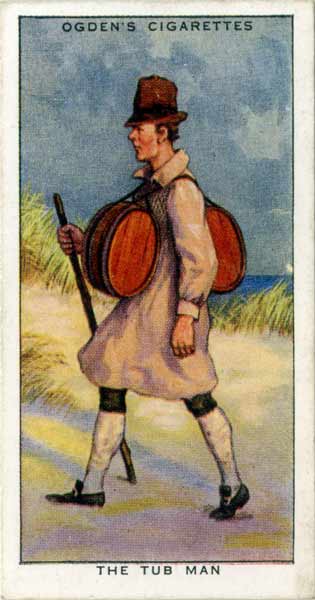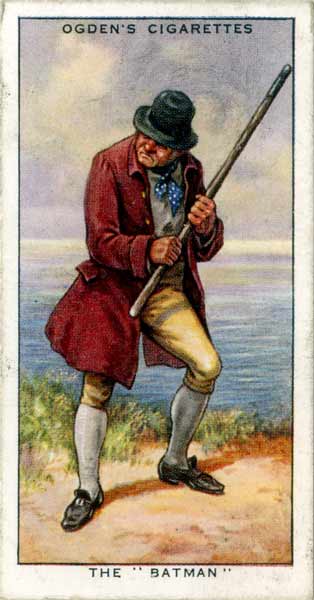I wanted to do a piece on Goudhurst Church and some of it's history, particularly smuggling which was rife in this area.
The church could be seen from Horsmonden platform and from the train on large parts of the line as it skirted around Goudhurst and it was said that from the tower people could watch the progress of trains from their smoke trails for miles.I had meant to do this months ago but apparently it was not safe to visit the church tower as some yobs had stolen lead from the church roof.
----------------------------------------------
Goudhurst is one of the highest villages in the Weald of Kent, some parts are at over 400 feet above sea level. Early records prove that there was a small church at the top of the hill as early as 1119, since then there have been many additions to the building as the local population increased. It had a 115 foot spire for a while but that was struck by lightening in 1637 and the present church was built with a tower soon afterwards.
At seventy odd feet the church tower is not high, but it is built on the highest point of land for miles around. The Star and Eagle Hotel, a smugglers pub, (right) stands next door, (both played a part in the events of 1747).
The church still has a few stained glass windows but most of them were blown out when two German parachute bombs exploded nearby during the Second World War.
There are several memorials to the influential Culpepper family, (merchants) who lived in nearby Bedgebury in the 1500's.
The smuggling epidemic of the mid Eighteenth Century
During this period, as Britain was able to colonize more countries with it's advanced seafaring technology of the time it was coming into conflict more and more with other peoples and Nations. Britain required an ever bigger army and navy to fight all these conflicts. Vast sums of money were required, so the Government slapped heavy taxes on imported goods and on it's colonists to pay for it's wars.
The Weald of Kent and Sussex was a large heavily wooded, hilly and sparsely populated area which came within twenty miles of London to it's north and at the other end, down to the south coast. It became profitable to import luxury goods at night from the continent to ports such as Rye and pay local people to move the goods inland towards the London and the hinterland avoiding the heavy excise duties. Poor people could earn five or six times more working as 'mules' than they would working in a field all day, Criminal gangs grew up to organise runs from the coast and their influences grew. They used many of the public houses as unofficial headquarters.
The only people able to vote at that time were the large landowners, there was no police force and hardly anyone could read or write, the country was made up of two nations who did not mix together, so that the governments of the day had little understanding of how people lived.
Solders and Revenue officers were employed by the Government to try to catch people smuggling goods inland. The revenue men tended to operate around the coasts so for the smugglers carrying goods inland, the first few miles were usually the most dangerous.

Some people were employed as 'tub men' carrying brandy or spirits inland perhaps ten miles in one night.

Or, if you were of a more thuggish temperament you might apply for a role as a 'batman'. It would be your duty to set about on anyone who may try to interfere with a smuggling operation.
Rudyard Kipling's evocative poem gives a good taste of what it might have been like for the local populace is always worth a read (see link below) but no one kept an account because they would be threatened with execution from the authorities or reprisals from the gang. Of course most people were illiterate anyway so we will never know for sure.
http://www.kiplingsociety.co.uk/poems_smuggler.htm
In response to the crime wave the Government kept imposing harsher and harsher sentences so that it was soon commonplace for captured smugglers to be hanged. When this didn't work the 'gibbet' was introduced. The corpse of the felon was hung up and displayed in a metal cage so that the body rotted and and crows pecked at the corpse. (At that time most people believed that a person could not go to heaven without a proper christian burial, thus the Government felt that they could legislate on a person's soul).

Captain Kidd's body displayed in a gibbet
The most notorious gang was known as the 'Hawkhurst Gang' they grew to control the Weald of Kent and Sussex and had influence as far west as Dorset. They became more and more violent as the Government imposed stricter and stricter penalties, although no doubt some of them could be philanthropic to the local population. There were a few documented cases of individuals being tortured and murdered when gang members felt that they had compromised the gangs safety. There must also have been many cases of robberies beatings, and rapes which were never published.
The Hawkhurst Gang were checked here.
William Sturt
Enter one William Sturt a son of Goudhurst who had been a corporal in the army. Upon returning home he was apparently shocked at the changes in Goudhurst. The story reads like a Clint Eastwood film.
He managed to raise a militia and begin training them secretly. He also apparently managed to obtain muskets, powder and shot.
An armed confrontation took place around the church on 21st April 1747 the militiamen had been stationed in upstairs windows of houses around the church and in the tower. They knew the gang members were coming and had managed to evacuate some of the population, others were locked in the church. These people had no access to television or books that could have told them the importance of sticking together and being disciplined when fighting a battle and some of them must have felt quite scared. It says something for the leadership qualities of Sturt that they kept their nerve, perhaps he had very good lieutenants.
http://www.goudhurstlocalhistorysociety.org/william-sturt-1718-1797/
Militia men were stationed in the church tower and upstairs windows of other buildings nearby like this one.
It is said that some of the gang members let off shots first. (There is a section of the old church door in a frame with lead shot in it). Presumably they were trying to intimidate the locals who were hiding in the church, maybe this strengthened the defenders resolve.
A section of the oak church door from 1747 apparently with lead shot in it.
When the militia did fire back it was a 'turkey shoot' as two gang members were killed immediately, both shot through the head. Other gang members fled but many were soon caught, handed to the authorities and later executed. The bodies of those killed were gibbeted, George Kingsmill the brother of the gang leader in Goudhurst and a William Farrall (from Horsmonden) were gibbeted in their home villages. In Horsmonden there is still a lane called 'Gibbet Lane' so named from where Farrall's gibbet stood.
Gibbet Lane lies just off from the 'Maidstone Road' close to the village green.
While the defeat of some of the Gang was a victory for the Government, the 'Boston Tea Party' was to take place in December of the same year (which was another event also caused by Goverment taxes on imported goods to pay for colonial wars.) and a precursor to the American War of Independence.
----------------------------------
There is supposed to be a headstone of George Kingsmill somewhere in the churchyard (although the two guides I met did not know where it was) I have seen a photograph in a book of a very weathered headstone with a vague impression of a skull on top, but it could easily be the grave of a black death victim.
The oldest gravestones are closest to the church but I could't find one with a skull on it when I looked.
Another probable urban myth is that there was a tunnel leading from the churchyard to Smugley Farm at the bottom of the hill a quarter of a mile away. This I find ridiculous, although there were secret hiding places and small tunnels built to to hide stashed contraband in many of the houses people would not have had the technology for such a massive enterprise.
The door leading to the church tower.
Views from the church tower.
The Weald of Kent and Sussex, once very rural and heavily wooded seems to have provoked fear to many city people. In all likely-hood there was probably less crime than in London. 'Black Bartlemy's Treasure', a smuggler''s yarn written by Jeoffrey Farnol describes reaching the village of Pembury in the first chapter:-
'And now, as I stood amid that howling darkness, my back propped by the bank, my face lifted to the tempest, I was aware of a strange sound, very shrill and fitful, that reached me 'twixt the booming wind-gusts, a sound that came and went, now loud and clear, anon faint and remote, and I wondered what it might be. Then the rushing dark was split asunder by a jagged lightning-flash, and I saw. Stark against the glare rose black shaft and crossbeam, wherefrom swung a creaking shape of rusty chains and iron bands that held together something shrivelled and black and wet with rain, a grisly thing that leapt on the buffeting wind, that strove and jerked as it would fain break free and hurl itself down upon me.
Now hearkening to the dismal creak of this chained thing, I fell to meditation. This awful shape (thought I) had been a man once, hale and strong,—even as I, but this man had contravened the law (even as I purposed to do) and he had died a rogue's death and so hung, rotting, in his chains, even as this my own body might do some day. And, hearkening to the shrill wail of his fetters, my flesh crept with loathing and I shivered'.













So I take it the tunnel from Lime Tree House was never opened again. It was deemed unsafe as it went under the A21 and onwards but I thought someone might have opened it up by now. I went down it with a telephone engineer still had the old candles there.
ReplyDelete